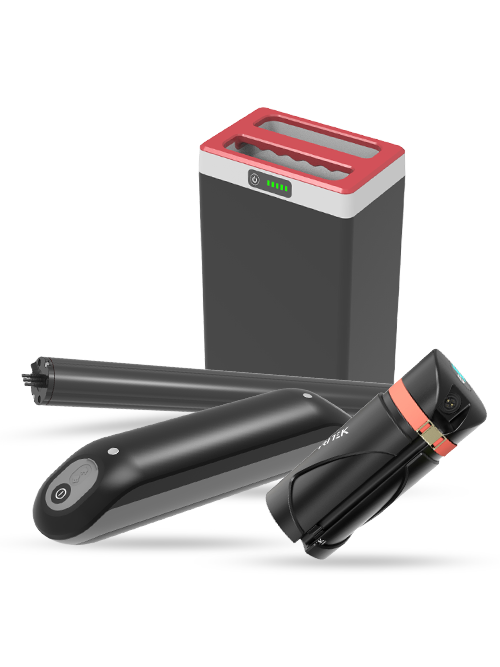In the last article, we introduced the comprehensive technical knowledge about lithium-ion cell, here we begin to further introduce the lithium battery protection board and BMS technical knowledge. This is a comprehensive guide to this summary from Tritek’s R&D Director.
Chapter 1 The origin of the protection board
1 Why do lithium batteries need protection
Lithium-ion batteries are most afraid of over-charging and over-discharging in use.
Voltage characteristics of batteries in different materials
Lithium iron phosphate(LiFePO) series: Factory standard charging cut-off voltage ≤3.85V, discharge cut-off voltage ≥2.5V
Nickel, Cobalt, Maganese(NCM) series: Cut-off voltage ≤4.2V, discharge cut-off voltage ≥2.7V
Lithium manganate(LMO) series: Cut-off voltage ≤4.2V, discharge cut-off voltage ≥2.7V
| charging cut-off voltage | discharge cut-off voltage | |
| LiFePo | ≤3.85V | ≥2.5V |
| NCM | ≤4.2V | ≥2.7V |
| LMO | ≤4.2V | ≥2.7V |
Term:
Over-charge: The charging voltage exceeds the upper limit voltage.
Over-discharge: The discharge cut-off voltage is lower than the lower limit voltage.
What are the consequences of lithium-ion battery over-charge and over-discharge?
Over-charge: A large amount of gas will be generated in the battery, which causes the internal pressure to rise rapidly, resulting in the battery explosion.
Over-discharge: reduced capacity, shortened battery life, direct damage lead to the battery scrap.
When the lithium battery is used in PACK, it is more likely to over-charge and over-discharge, which is caused by the consistency difference of the cell. If the charging and discharging process is not properly controlled, it will be further increased, resulting in the phenomenon of over-charging and over-discharging of part of the cell.
Lithium batteries are great, but they need protection. In order to ensure the safety of use, there are many requirements:
Basic protection requirements: over-charge protection, over-discharge protection.
Strengthen protection requirements: over-current protection, high-temperature protection, low-temperature protection, short circuit protection, reverse protection.
Expansion requirements: good consistency, small dropout voltage, small temperature difference.
Because of the material characteristics of the lithium battery itself, it can not be over-charge, over-discharge, over-current, short-circuit and ultra high or low temperature charge and discharge, so the application of lithium battery always needs a protection circuit.
After solving the security problem, according to different use environments and use occasions, the customer put forward many additional functional requirements:
- Communication function – Customer needs to know the running status of battery PACK, such as RS232 / RS485 / CAN etc.;
- SOC(State Of Charge) calculation/SOH(State of health) estimation;
- Warning function – Inform customers of battery problems;
- Record function – Record the historical running data of battery PACK , including historical alarm data;
- Fault diagnosis function – The protection board or management system itself should be able to diagnose problems;
- Display function – Customers can directly read information and set parameters through the display;
- Balancing function, thermal management, etc.
You can get any additional function you want from Tritek.
2 Lithium battery protection product classification
In order to meet different needs, there are many types of lithium battery protection products.

Chapter 2 Hardware-type protection board
1 Characteristics and classification of the hardware-type protection board
Hardware-type protection board:
Use special lithium battery protection chip, when the battery voltage reaches the upper limit or lower limit, the control switch device MOS tube cut off the charging circuit or discharging circuit, to achieve the purpose of protecting the battery pack.
Characteristics:
1. Only over-charge and over-discharge protection can be realized. Partial can realize over current protection, short circuit protection, over temperature protection, and reverse connection protection. None of the other additional functions can be satisfied.
2. Protection threshold cannot be changed (general protection point is 3.9V and 2.0V)
3. The balance threshold cannot be changed (general balance current below 150mA)
Classification:
Hardware-type protection board can be divided into:
Separate port protection board – Totally three ports: Charging port, discharge port, common terminal
Common port(Same port) protection board – Totally two ports: Positive and negative port
2 Hardware-type protection board physical appearance
Below is the physical appearance of the Hardware-type protection board:
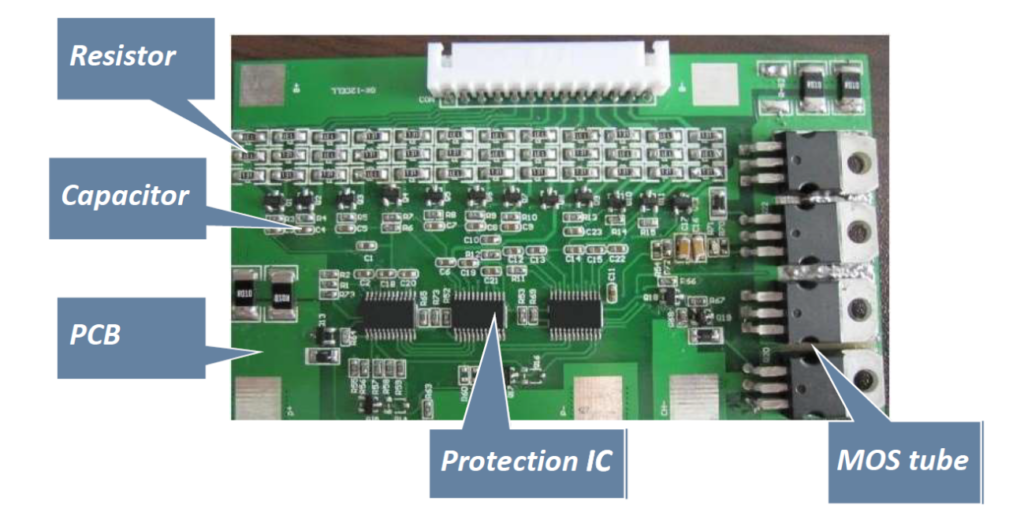
3 Separate port Hardware-type protection board
Charging and discharging circuit is different, i.e., charging and discharging port are separated.
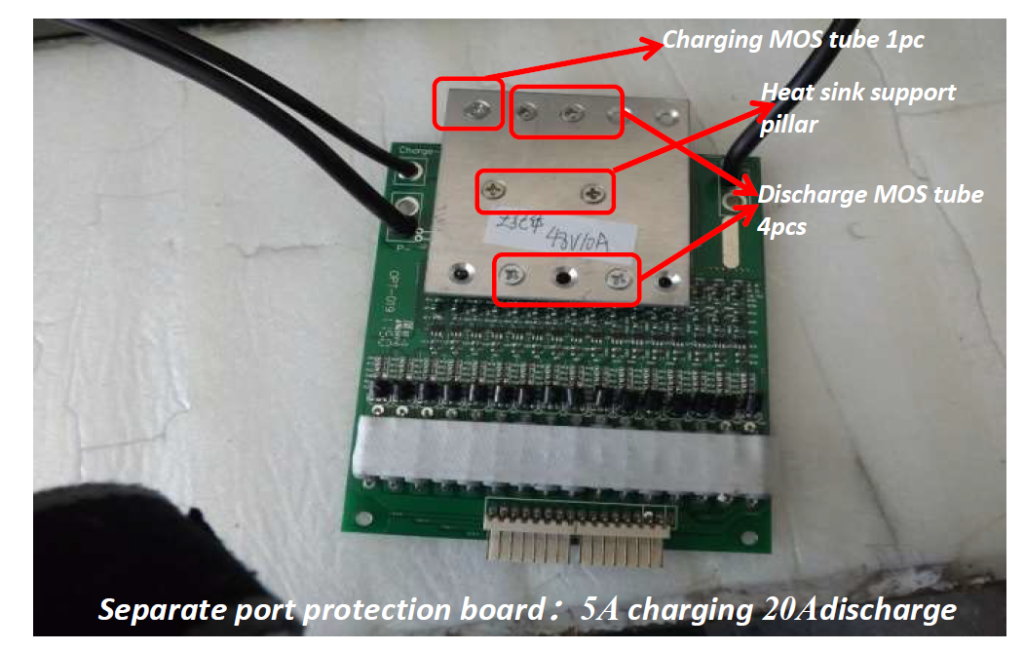
4 Common port(Same port) Hardware-type protection board
Charging and discharging circuit is the same circuit, i.e., charging and discharging share a same port.
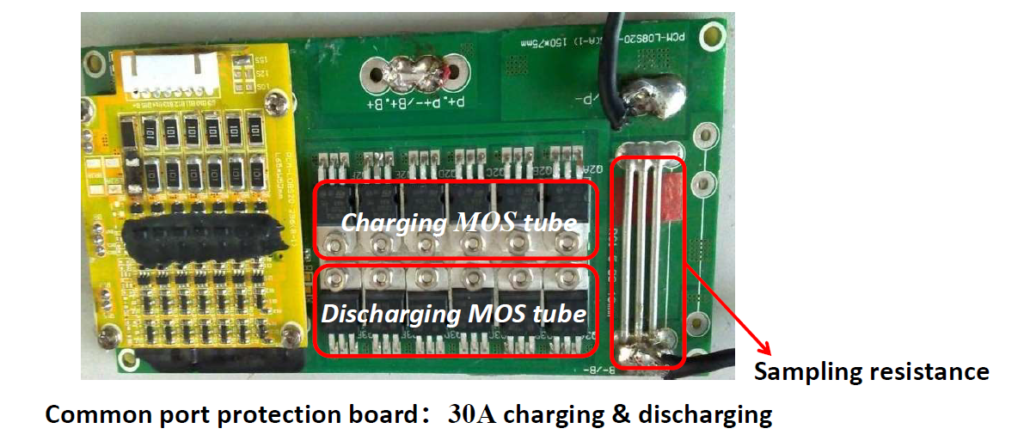
5 The difference between the Separate port and Common port(Same port)
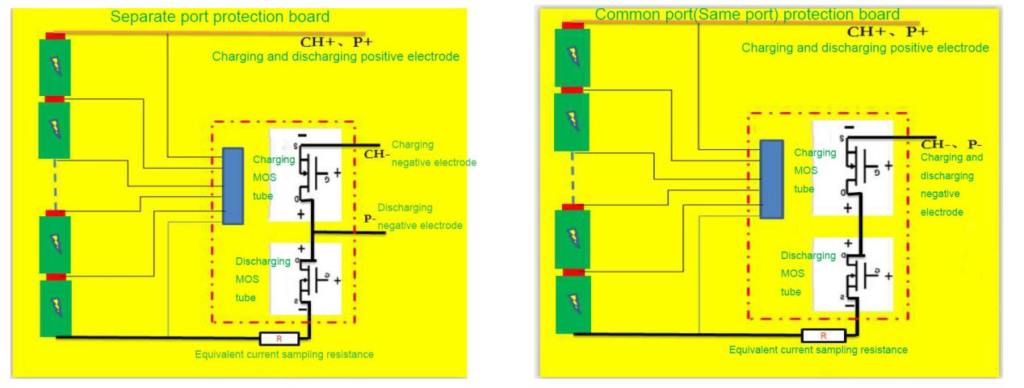
Why do we need to distinguish between common and separate port?
- For customers, generally do not care about the separate port or common port. All we have to do is provide them with positive and negative battery electrodes. But some customers’ charge port and discharge port share a common port, some customers require the charging port and discharge port can be separated wiring.
- The over-current capacity of the protective board is determined by the over-current capacity and quantity of the MOS tube. The MOS tube accounts for most of the cost of the protective board. Generally speaking, the charging current is smaller and the discharge current is larger. For this application requirement, we designed a separate port protection board to reduce the cost.
Some knowledge about the separate port protection board and common port protection board:
- The control mode of the separate port protection board and the common port protection board is the same;
- The over-current capacity of the protection board is determined by the over-current capacity and quantity of the MOS tube;
- The charging MOS tube is connected in series with the discharging MOS tube in the case of common port and half-separate port; The full separate port is parallel;
- The number of charging MOS tubes is less than or equal to the number of discharging MOS tubes;
- The number of charging MOS tubes of the common port protection board is equal to the number of discharging MOS tubes, and the total number of MOS tubes must be even number.
- The number of charging MOS tubes of separate port protection boards is generally less than discharging MOS tubes.
- The common port protection board can be used directly as the separate port protection board, choosing common port protection board when the charging current larger than the discharge current;
- In principle, the separate port can not be used as a common port, either charging MOS tube overload and over-current, or discharging MOS tube waste;
- The MOS tube of the protection board is relatively expensive, in the final analysis, the purpose of the separate protection board is to make reasonable use of the MOS tube flow capacity, not waste and save money.
6 The selection principle of separate port and common port(same port)
The basic principle:
- Some customers who understand the principle and cost of the protection board will specify the use of separate or common port, in which case the customer has the final say.
- If the charging current is low, the discharge current is high. For example, charge 5A, discharge 20A. Separate port is recommended. (1 MOS tube for charging and 4 MOS tubes for discharge)
- If the charge current is similar to the discharge current, or the charge current is larger than the discharge current. Common port board is recommended. (There are as many charging MOS as discharging MOS)
7 Basic working principle of the protection board
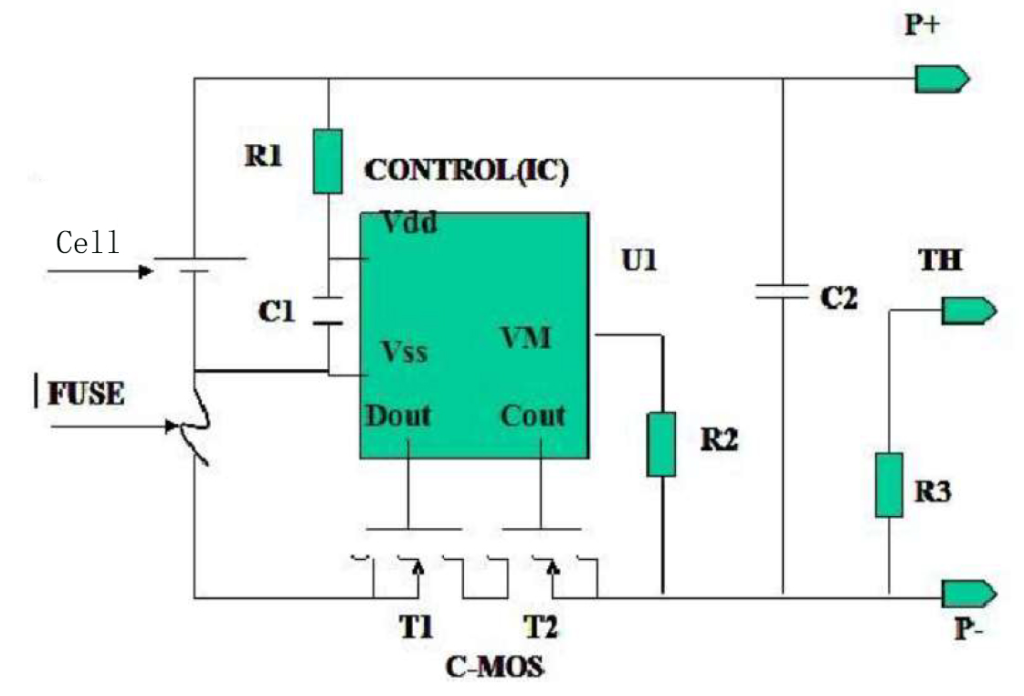
Single section general protection board schematic diagram (typical)
U1: control IC; All functions of the protection board are realized by IC monitoring the voltage difference between VDD-VSS and VM-VSS and controlling C-MOS to perform switching actions.
Cout: overcharge control terminal; The switch of the MOS tube is controlled by T2 grid voltage of MOS tube.
Dout: over discharge, over current, short circuit control terminal; The switch of the MOS tube is controlled by the T1 grid voltage of the MOS tube.
VM (V-) : over current and short circuit protection voltage detection terminal; The over current and short circuit protection can be realized by detecting the voltage of VM terminal.(U(VM)=I*R(MOSFET))
When the protection board is normal, Vdd is high level, Vss and VM are low level, and Dout and Cout are high level. When any parameter of Vdd, Vss and VM is transformed, the level of Dout or Cout will change. At this time, MOSFET executes the corresponding action (open or close the circuit), so as to realize the protection and recovery function of the circuit.
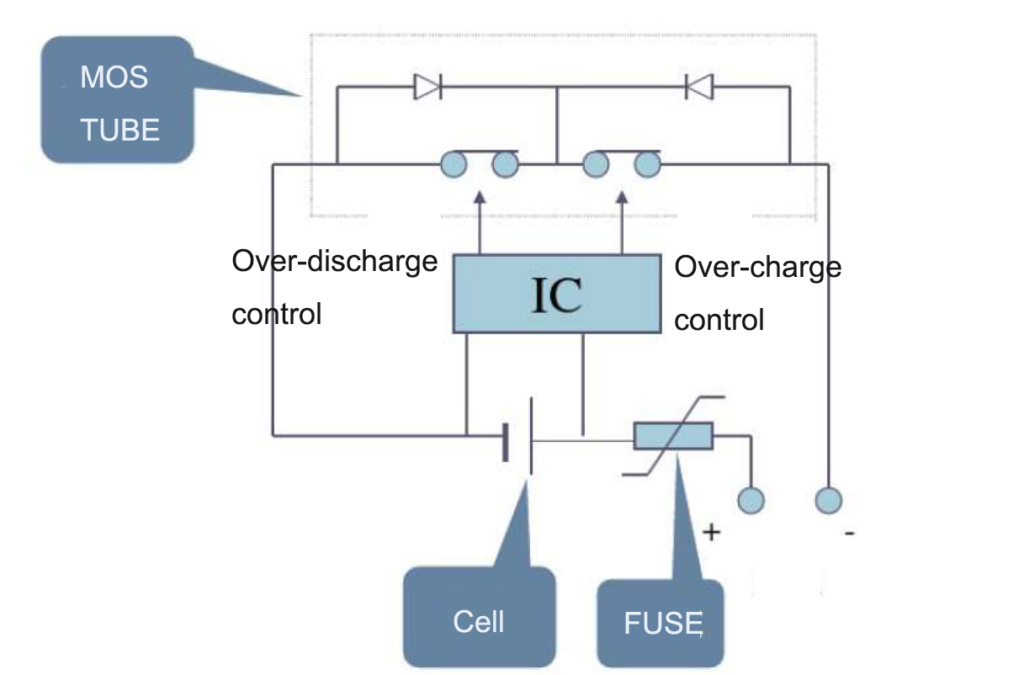
Protective board schematic diagram (simplified diagram)
1: General state
When the battery voltage is above the over-discharge detection voltage (above 2.75V) and below the over-charge detection voltage (below 4.3V), the voltage of the VM terminal is above the charger detection voltage, and when the over-current/detection voltage is below the OV, IC controls the MOS tube by monitoring the voltage difference between VDD-VSS and VM-VSS. The DO and CO terminals are high level, and the MOS tube is in the on-off state. At this time, it can charge and discharge freely.
As shown in the picture below, IC is powered by a battery cell and can work reliably at a voltage of 2v-5v.
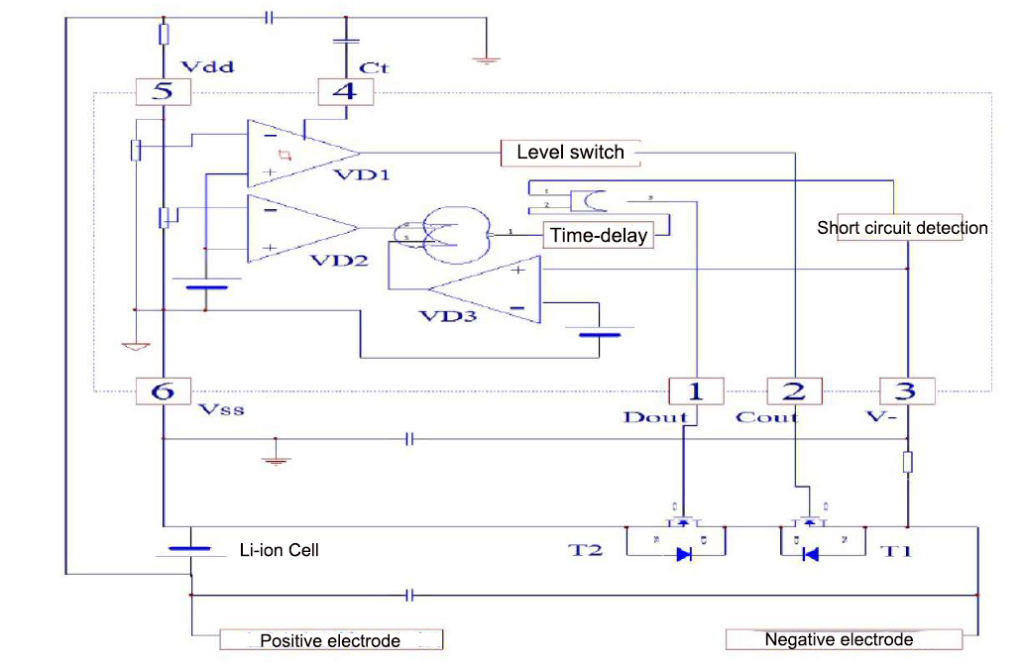
2: Over-charge protection and recovery
When the battery is charged to the voltage exceeds the set value VC(4.25-4.35V, the specific overcharge protection voltage depends on IC), VD1 reverses so that Cout becomes low level, T1 cutoff, and charging stops. When the battery voltage falls back to VCR(3.8-4.1V, the specific recovery voltage of overcharge protection depends on IC), Cout becomes high level, T1 switches on charging to continue, and VCR must be less than VC with a fixed value to prevent frequent jump.
In addition, adding load discharge at the end of the output to the battery voltage less than the over-charge protection voltage can be also recovered.
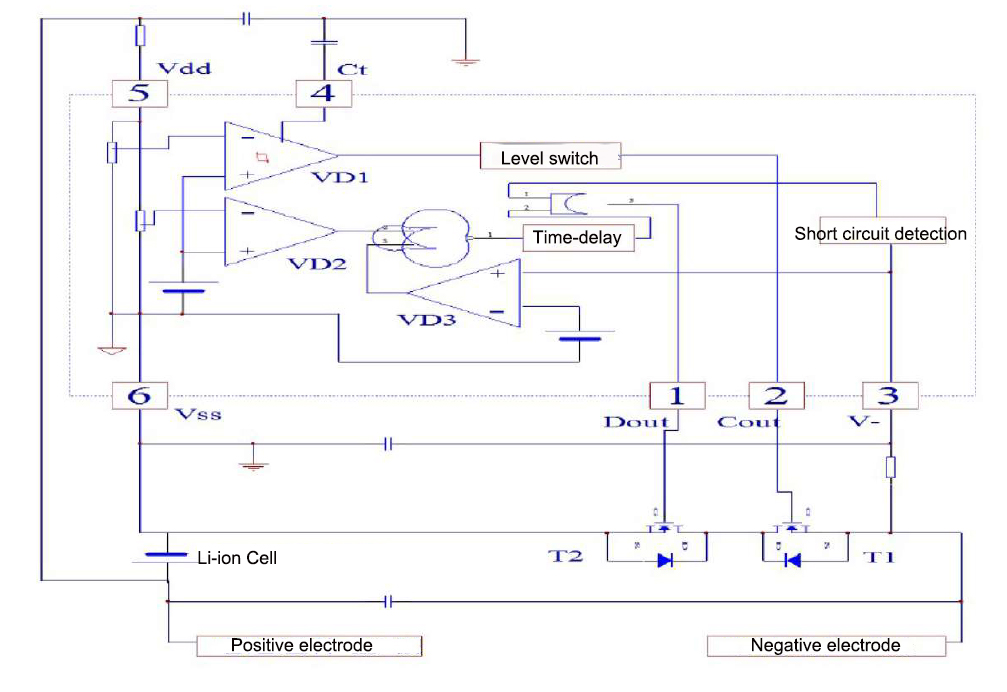
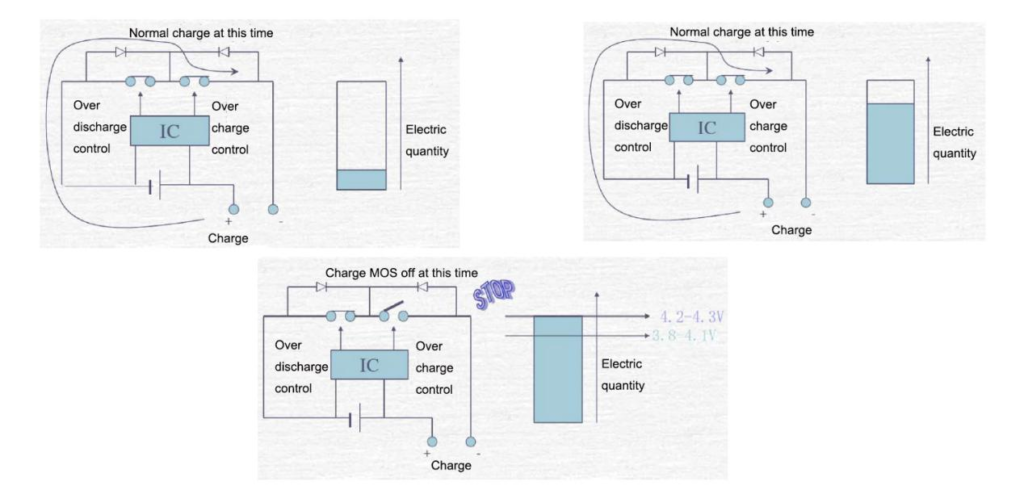
3: Over-discharge protection and recovery
When the battery voltage is reduced to the set value VD (2.3-2.5V, the specific overcharge protection voltage depends on IC) due to discharge, VD2 reverses, and after a short time delay fixed in IC, Dout becomes low level, T2 is cut off, and discharge stops.
Remove the load or when the battery is placed on charge, the interior or door is turned over so that T2 is switched on again in preparation for the next discharge.
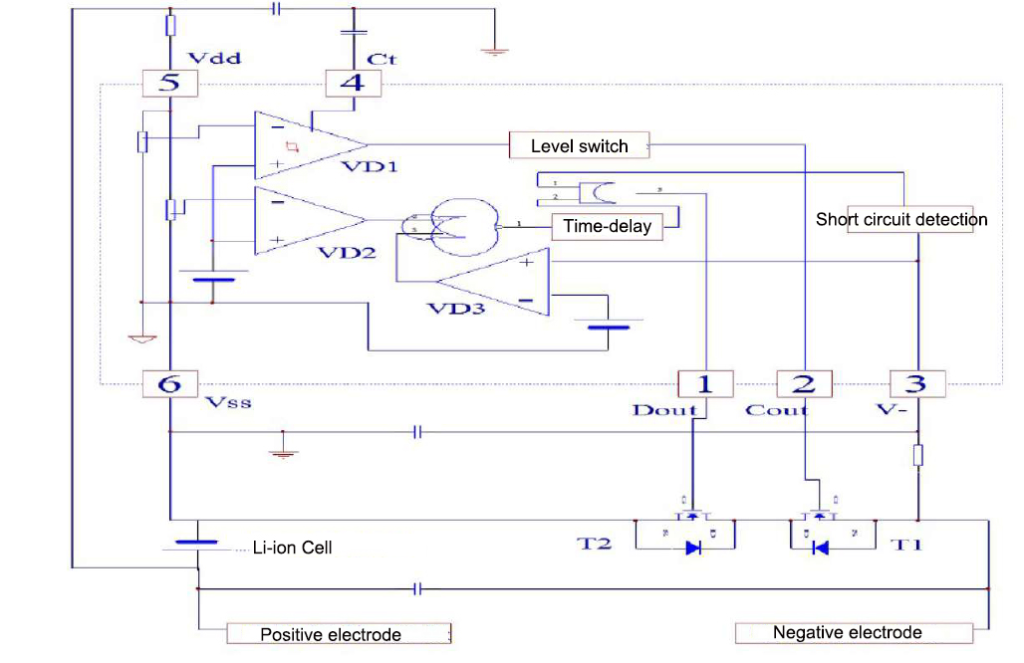
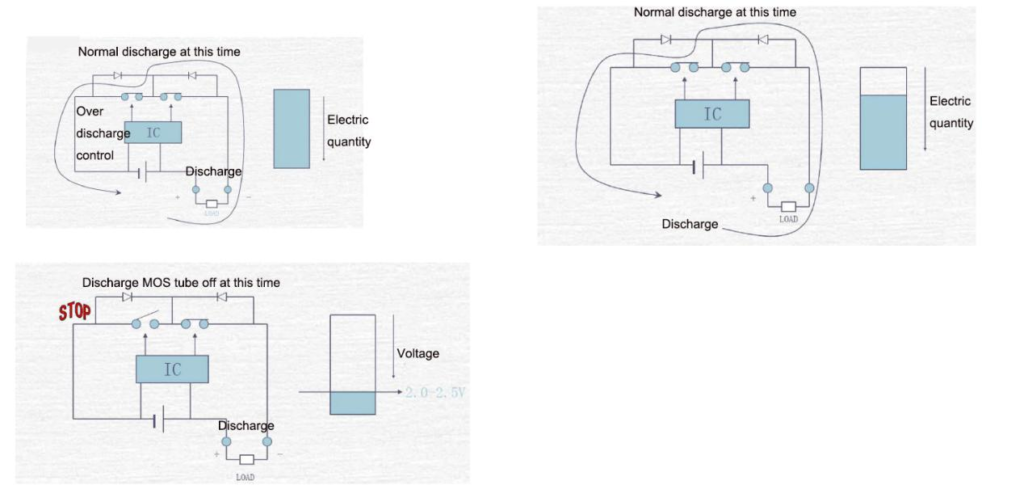
4: Discharge over-current, short circuit protection and recovery
When the circuit discharge current exceeds the set value or the output is short-circuited, the over-current, short-circuit detection circuit action, so that the MOS tube (T2) off, current cut-off.
Remove the load or when the impedance between P+ and P- is above the automatic recovery impedance can be recovered.
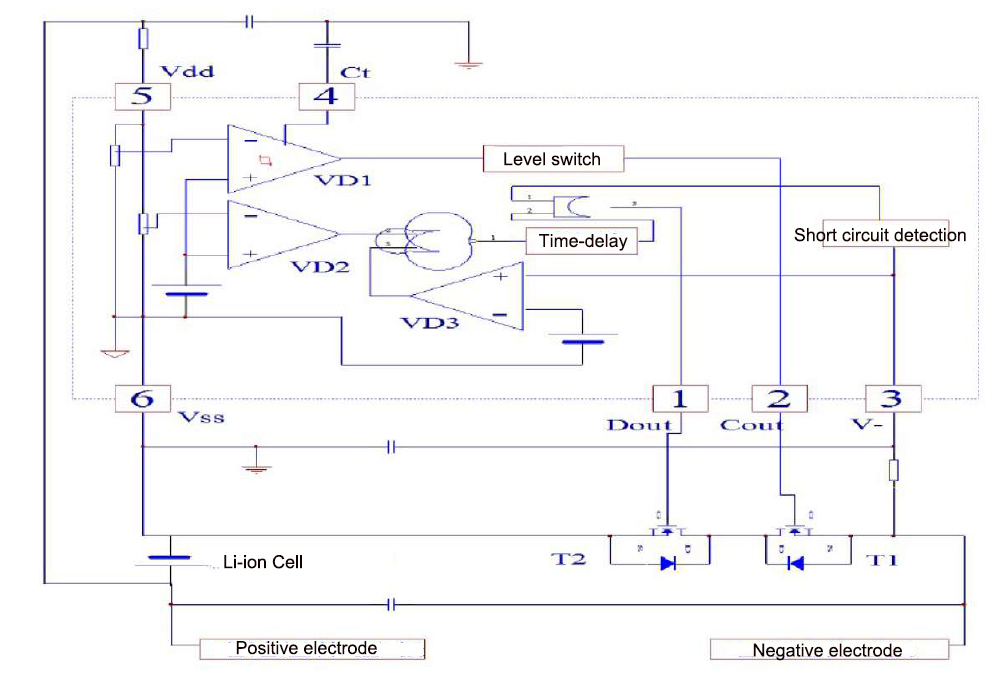
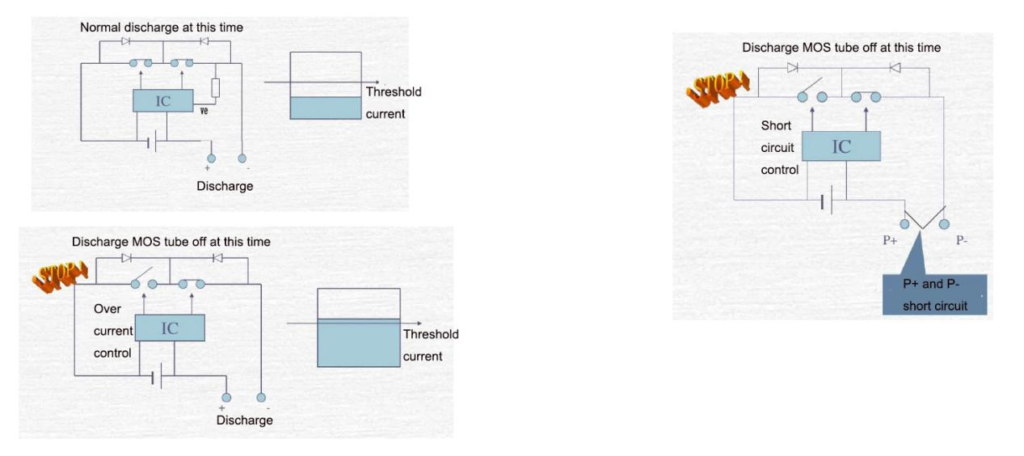
5: Charge over-current protection and recovery
When the circuit charging current exceeds the set value, over-current, short circuit detection circuit action, so that the charging MOS tube (CHG) off, current cut-off.
When the charger is unplugged, the system will return to normal operation when the V-pin is restored to the charge over-current detection voltage or higher.
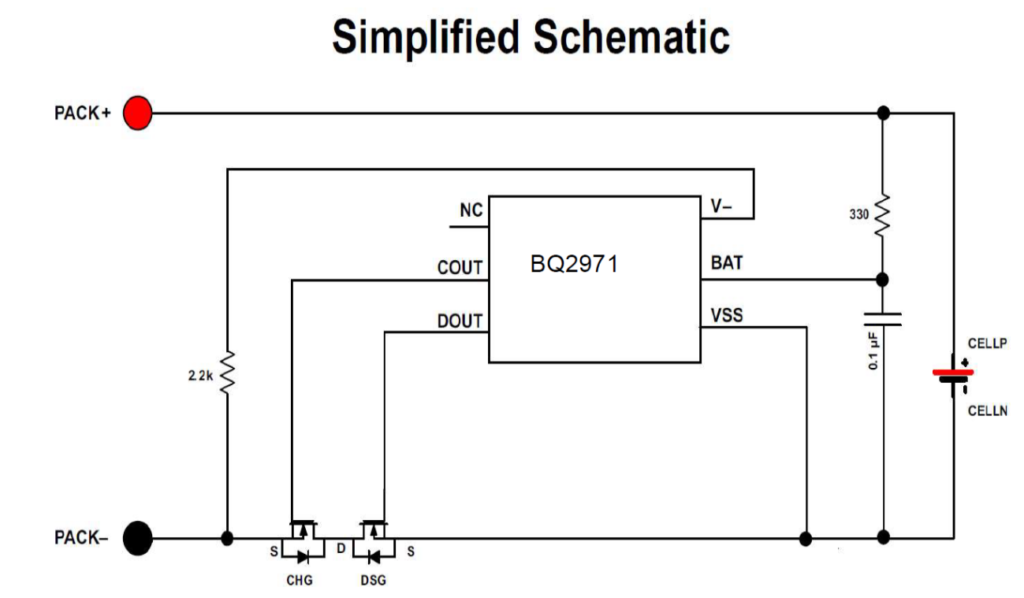
As with the single cell, in the multi-cell protection circuit, the protection board must also be able to provide over-charge, over-discharge, over-current, short circuit protection against the cell.
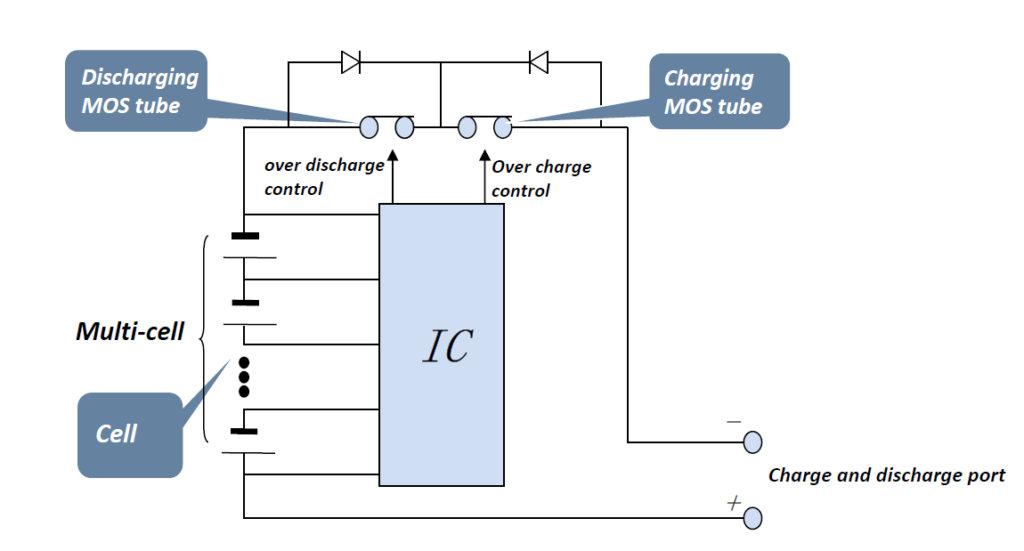
Chapter 3 Software-type protection board
1 Software-type protection board physical appearance
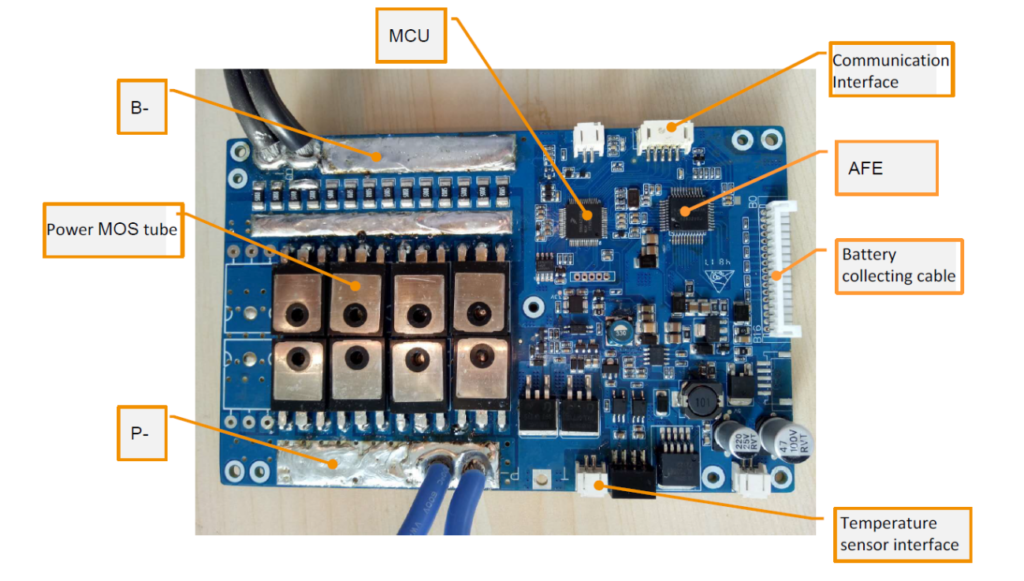
2 Software-type protection board System schematic
Below is system schematic of software-type protection board:
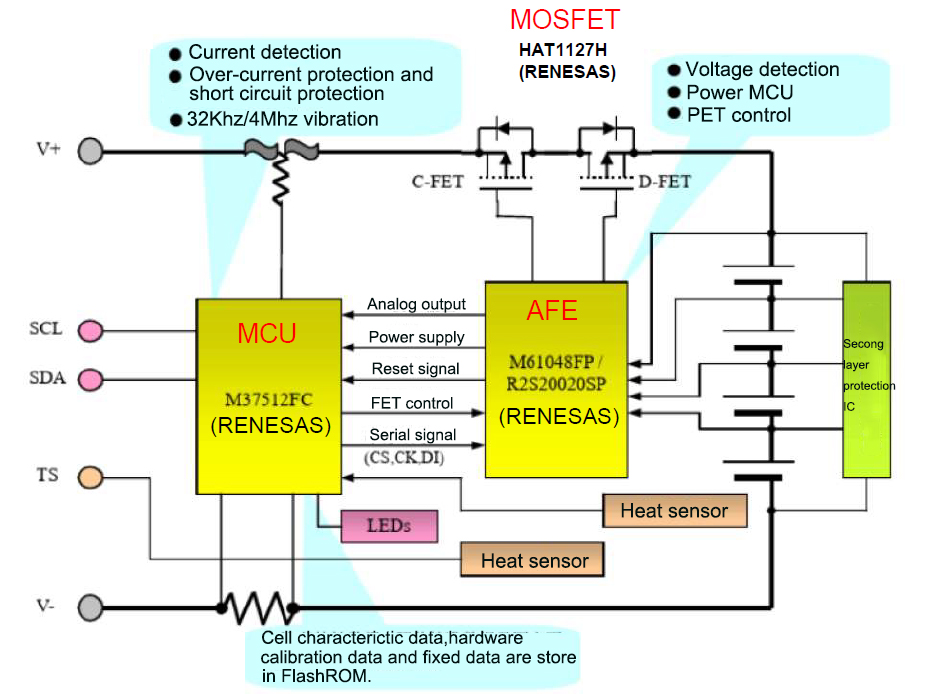
3 Characteristics and classification of the software-type protection board
In addition to the basic functions of the hardware-type protection board such as over-charge, over-discharge, over-current, over-temperature, short circuit, etc., it also has the following functions:
Communication functions: CAN/RS485/RS232/UART/I2C/SMBus/ModBus, Bluetooth, WIFI, GPS+GPRS, 4G
Battery condition estimation(SOC/SOH)
Warning function
Online fault diagnosis function
Data storage and record function
Display function
Balancing function
Charge and discharge management
Thermal management
Classification:
- Classified by use: communication base station, backup power supply (UPS) protection board, automotive starting power supply protection board, energy storage protection board, power battery protection board, etc
- Classified by charge and discharge port: same port, separate port (half separated port, full separated port)
- Classified by control switch: MOS tube version, relay version
4 The difference between MOS tube and relay
MOS tube:
Advantage: Voltage driven, electronic switch, no touch spot, small size, fast switching speed, high working frequency, no electromagnetic interference, equipped direction, quiet action
Disadvantage: Severely emit heat, with high temperature derating characteristics, the higher the temperature, the worse the over-current ability, the MOS tube is best to have a better heat dissipation environment; Exceeding the voltage range will result in breakdown or burnout.
MOS tube is selected within 120A-150A over-current.
Relay:
Advantage: Current driven, electromagnetic control of the physical switch, more safe and stable compared with MOS tube which can withstand higher power; slightly heat, and excellent over-current ability even without heat dissipation environment.
Disadvantage: Have touch spot, large volume, low working frequency, electromagnetic interference, noise; There is a limit of operation times, and the operation time is much slower than that of MOS tube.
Chapter 4 Battery management system(BMS)
1 Introduction to the Battery Management System (BMS)
BMS is the abbreviation of Battery Management System, commonly known as battery nanny or battery housekeeper. It is an electronic device that can monitor and manage the battery. It can control the charging and discharging process of the battery by collecting and calculating the voltage, current, temperature and SOC of the storage, so as to realize the protection of the battery and improve the comprehensive performance of the battery.

2 BMS system architecture
1. Master-slave Architecture(Centralized): It has the advantages of low cost, compact structure, and high reliability. It is commonly used in scenarios where the capacity is low, the total voltage is low, and the battery system volume is small. Such as power tools, intelligent robots (handling robots, assist robots), IOT smart home (sweeping robots, electric vacuum cleaners), electric forklift, electric low-speed vehicles (electric bicycles, electric motorcycles, electric sightseeing vehicles, electric patrol cars, electric golf carts, etc.), light hybrid vehicles.
2. Master-slave separation type(Distributed): Electric vehicles (pure electric, plug-in hybrid), electric ships, etc.
3. Three-tier architecture: Container energy storage system (EMS), energy storage power station
4.2 BMS system architecture – Master-slave type(Distributed)
Below is the general architecture diagram of Master-slave type(Distributed):
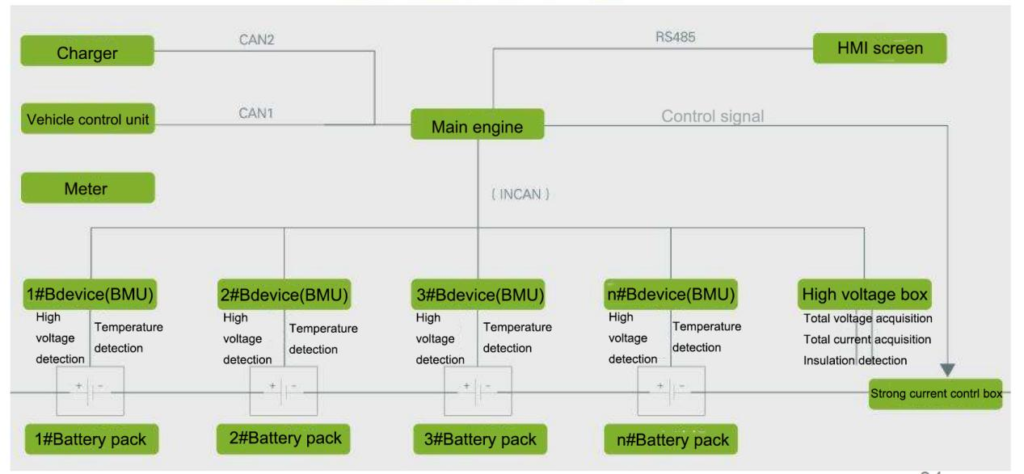
3 BMS electric system diagram
Below is a diagram of the master-slave electric vehicle BMS system:
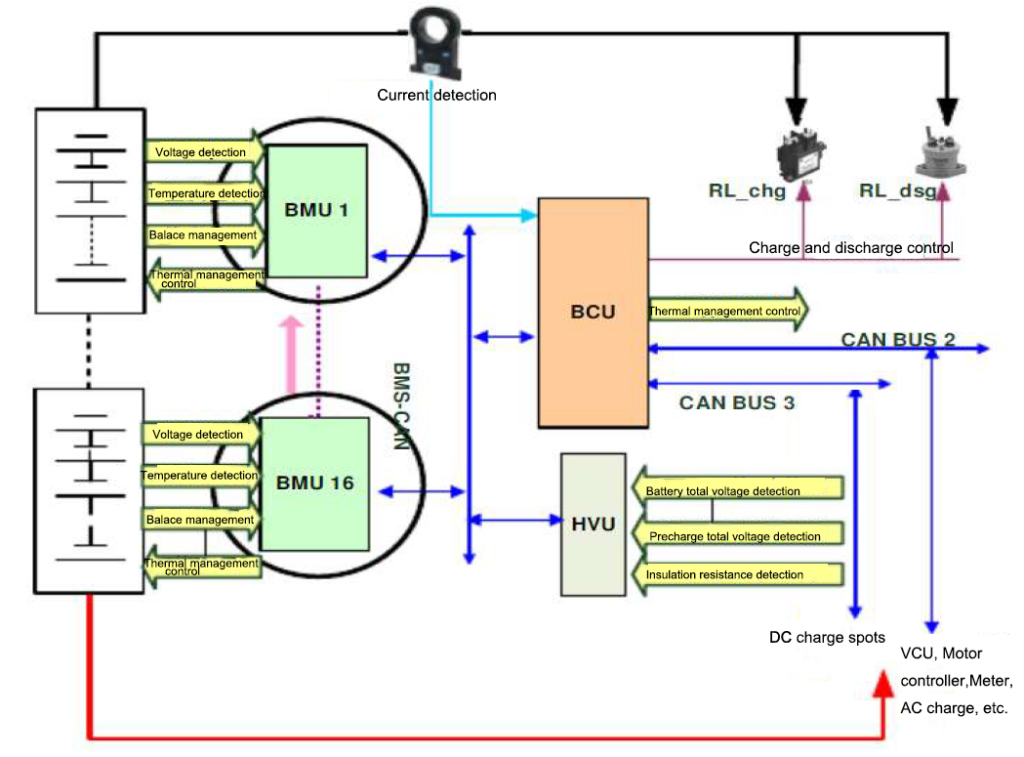
4 BCU hardware block diagram
The main control module BCU:
Receive and comprehensively judge basic battery information, calculate SOC,
Upload or issue control instructions,
Carry out external relay control,
The whole vehicle CAN communication,
Charging CAN communication,
Intranet CAN communication,
Data storage,
Input/output signal detection,
Charging and discharging current collection; etc.
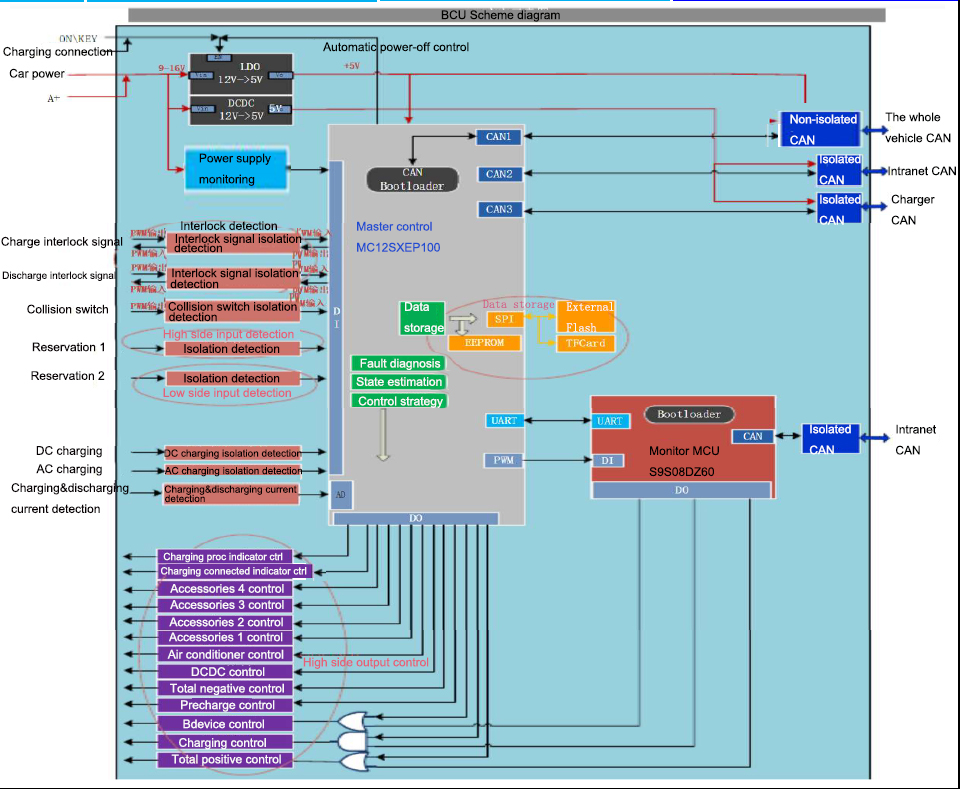
5 BMU hardware block diagram
Battery information monitoring module (Slave module) BMU:
Single battery voltage acquisition,
Battery temperature acquisition,
Battery balance management,
Thermal management function of single box battery,
Intranet CAN communication; etc.
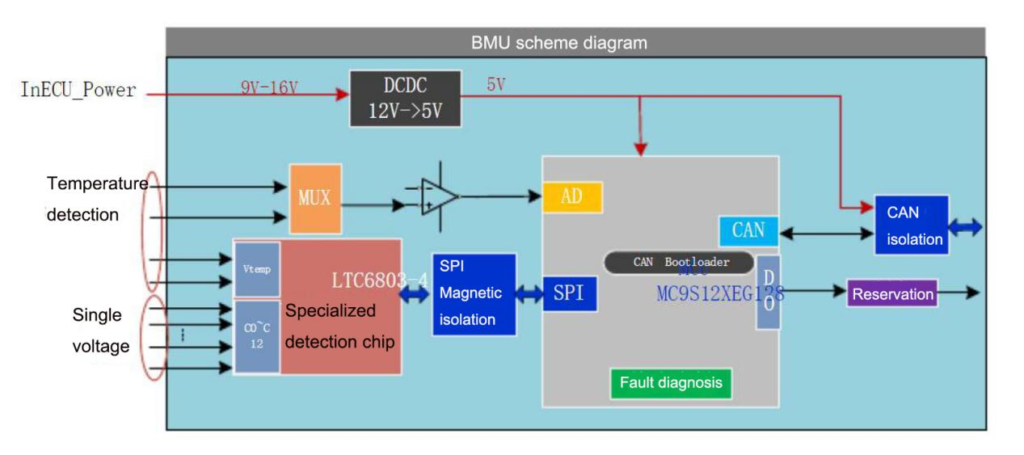
6 HVU hardware block diagram
Insulation monitoring module HVU:
Battery pack insulation detection,
Battery pack total voltage detection,
Motor controller precharge voltage detection,
Intranet CAN communication; etc.
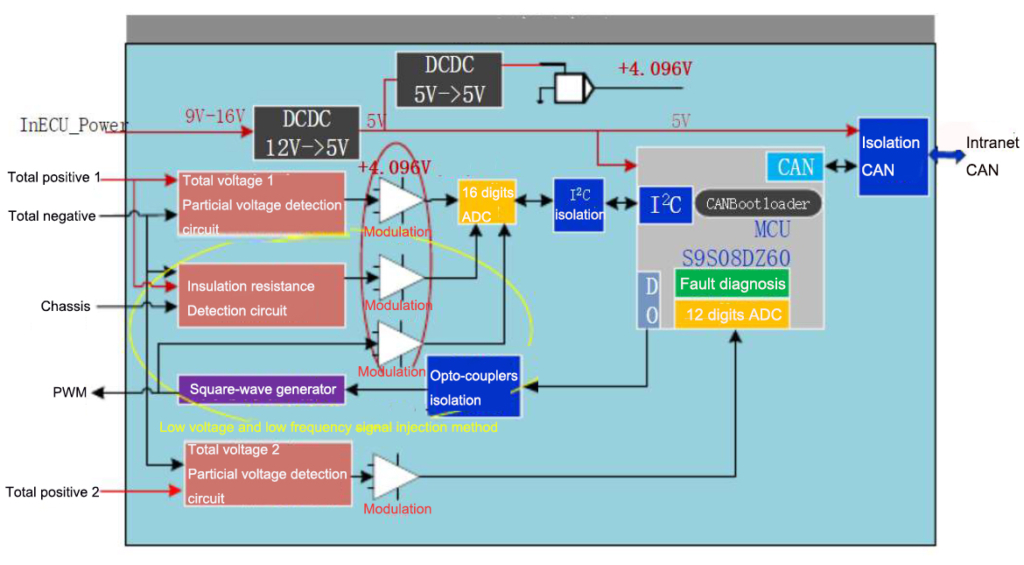
7 Overall architecture of BCU software
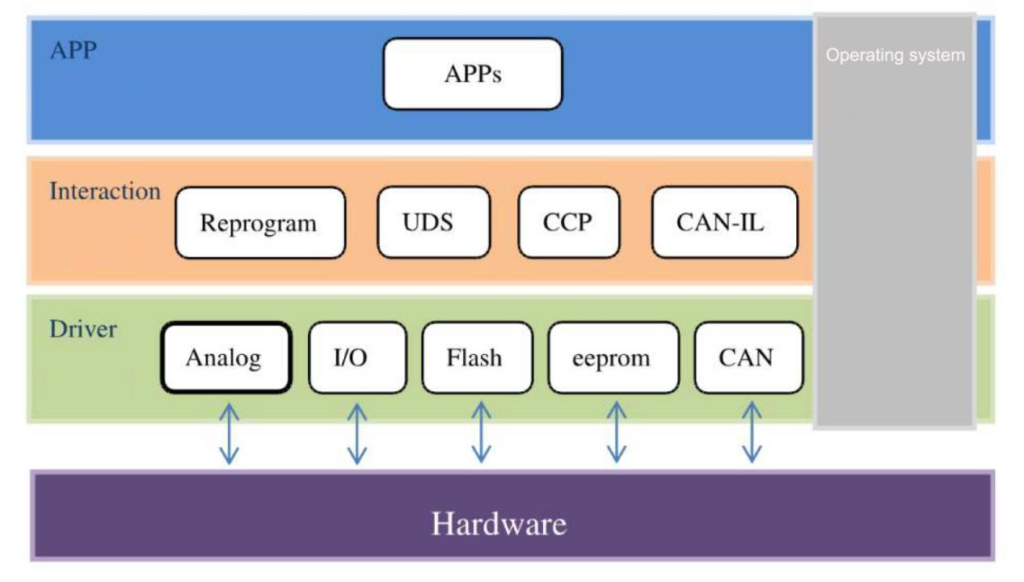
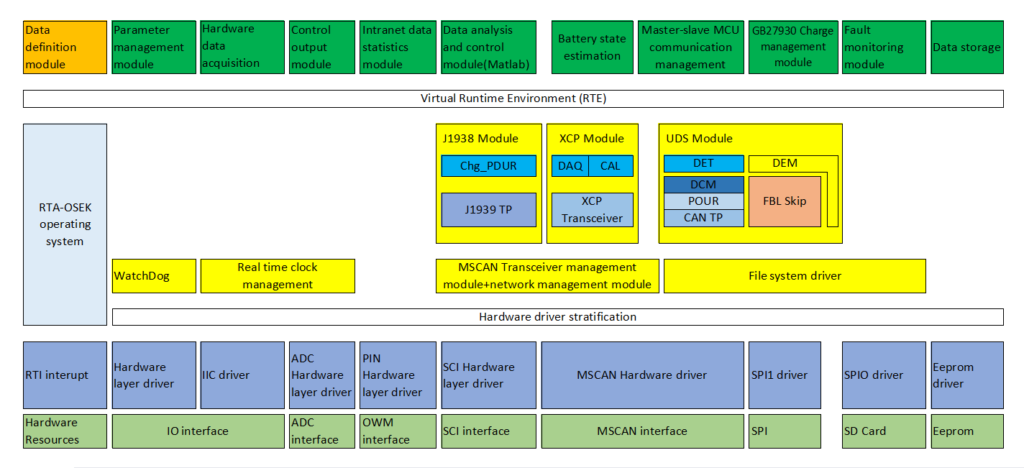
8 BMS function
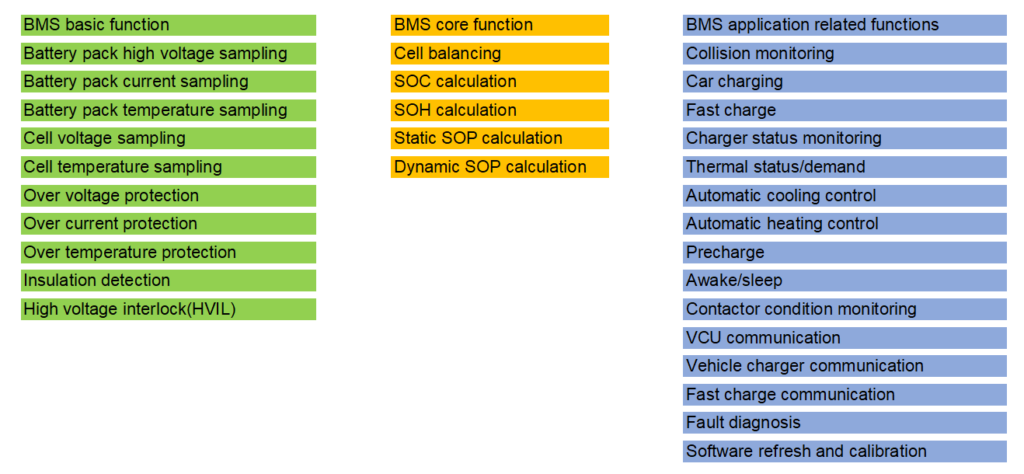
BMS basic function:
Battery pack high voltage sampling, battery pack current sampling, battery pack temperature sampling, cell voltage sampling, cell temperature sampling, over voltage protection, over current protection, over temperature protection, insulation detection, high voltage interlock(HVIL), etc.
BMS core function:
Cell balancing, SOC calculation, SOH calculation, static SOP calculation, dynamic SOP calculation, etc.
BMS application related functions:
Collision monitoring, car charging, fast charge, charger status monitoring, thermal status/demand, automatic cooling control, automatic heating control, precharge, awake/sleep, contactor condition monitoring, VCU communication, vehicle charger communication, fast charge communication, fault diagnosis, software refresh and calibration, etc.
9 Cell equalization technology
Just as there are no two identical leaves on the same tree, there is no way to guarantee that each cell is 100% identical during the cell manufacturing process.
Even assuming that the battery cells are exactly the same, they are not in the same environment in the battery pack. For example, the temperature difference around is often relatively large, and it will gradually change with the increase of service life and charge and discharge times.
According to the Cannikin law, the worst-performing cell reaches the cut-off condition first when charging and discharging, while other cells still have some capacity not released, resulting in battery waste.
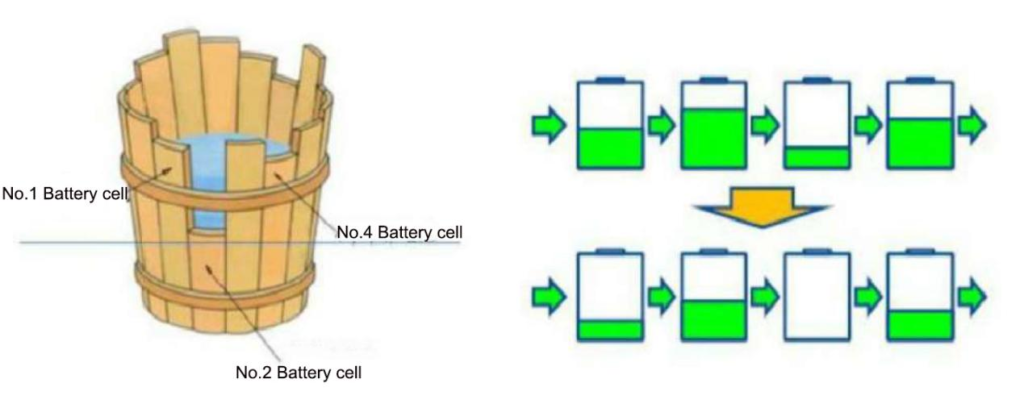
The equalization function is to designed eliminate the inconsistencies of battery cells during battery use.
There are three variables that can be measured in real-time outside the cell: voltage V, current I, and temperature T. The variable information can be introduced into the algorithm to determine the SOC value of each cell and the available capacity of the cell at this time, and to determine the inconsistency between cells to decide whether the pack needs to enter the equilibrium state.
There are two main types of battery equalization technologies: passive equalization and active equalization.
Passive equalization:
Also known as energy dissipation equalization, the principle of operation is to connect a resistor in parallel to each battery cell, when a battery cell has been fully charged in advance and needs to continue to charge other cells, the resistor is connected and discharged to dissipate the excess energy.
Passive equalization is suitable for small capacities and low series counts.
Active equalization:
Also known as non-energy dissipative equalization, active equalization transfers excess electricity to high-capacity cell when charging, and to low-capacity cell when discharging. Active equalization is the transfer of energy from more cell to less cell.
The advantages of active equalization circuit are less energy consumption, but complex topology, high cost, high requirements for electrical components, and large volume of capacitors and inductors lead to large space requirements, etc.
Active equalization is suitable for high-series and large-capacity power lithium battery pack applications.

- Passive equalization scheme
Advantages: Simple circuit structure, low cost
Disadvantages: Only charging equalization can be done. At the same time, the excess energy is released as heat during the charge equalization process, making the whole system of low efficiency, high power consumption, balance current 50-100mA.
BMS application: electric bicycle, electric motorcycle
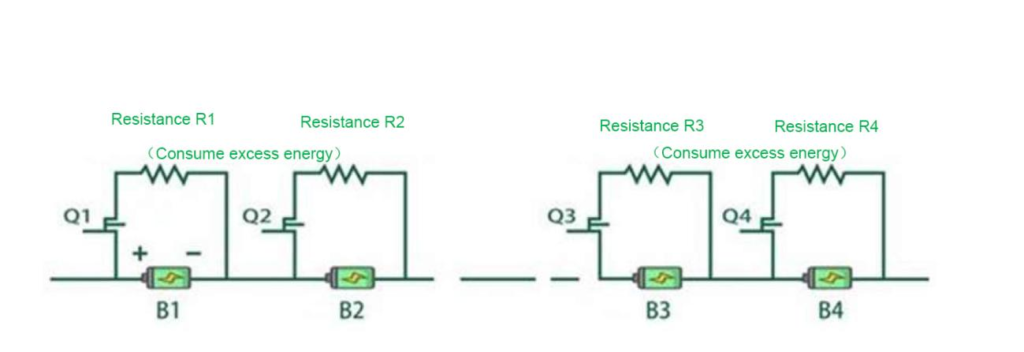
Switching resistance consumption equalization method
- Flying capacitor scheme
Advantages: Low cost, simple structure, high active energy utilization.
Disadvantages: Limited equalization efficiency, the capacitor is used as the carrier of energy transfer. This scheme can realize the direct transfer of energy between any two cells of the battery pack. Because the equalization current is limited by the difference between the capacitor voltage and the voltage of a single battery pack, the equalization speed becomes slower and slower as the equalization process progresses. The equalization current is about 300mA in mass production.
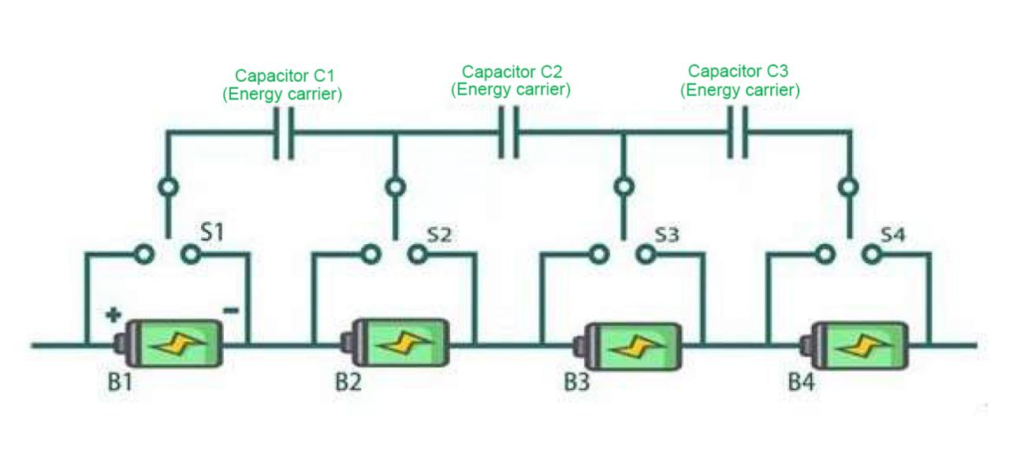
Flying(switched) capacitor equalization method
- DC/DC One-way equalization
Equalization performance is limited, the equalization current of mass production can reach to 1A.
- DC/DC Two-way equalization
Ideal equalization effect, high cost, complex structure, suitable for large power battery or energy storage battery, the equalization current of mass production can reach to 5A.

DC/DC converter equalization method – One way
- Multi-winding transformer
The design is complex and expensive. The number of windings needs to be changed according to the number of different battery cells, which is not easy to expand the battery pack and can only be balanced by charging the battery cells.
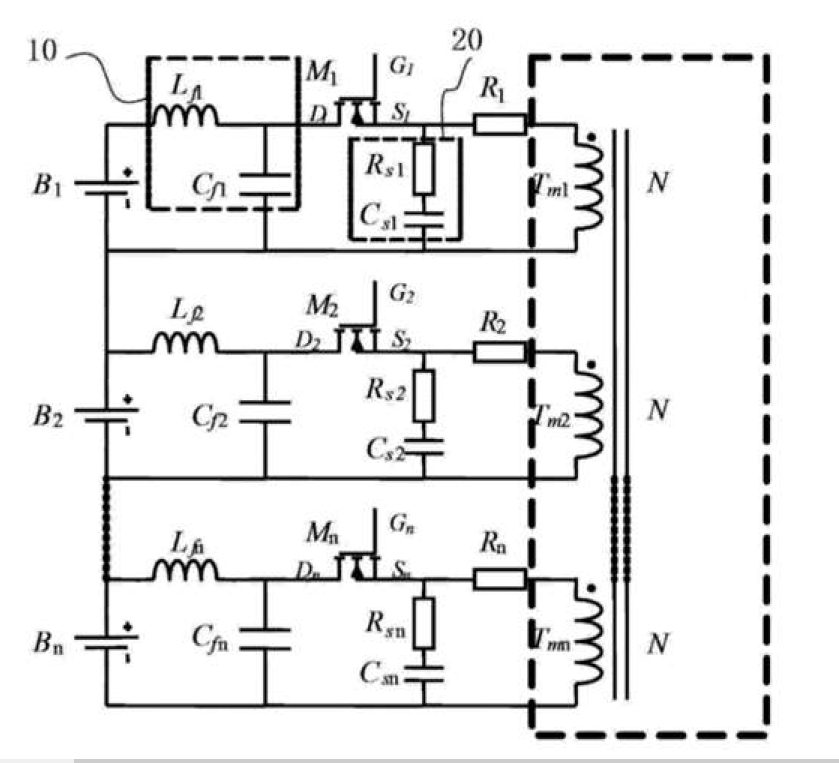
Multi-winding transformer equalization method
- Dumping inductor scheme
Advantages: Active energy utilization is high, the equalization effect is greater than capacitor scheme, the equalization current 5A in mass production
Disadvantages:
1. Energy can only be transferred between adjacent cells.
2. High cost and complex structure.
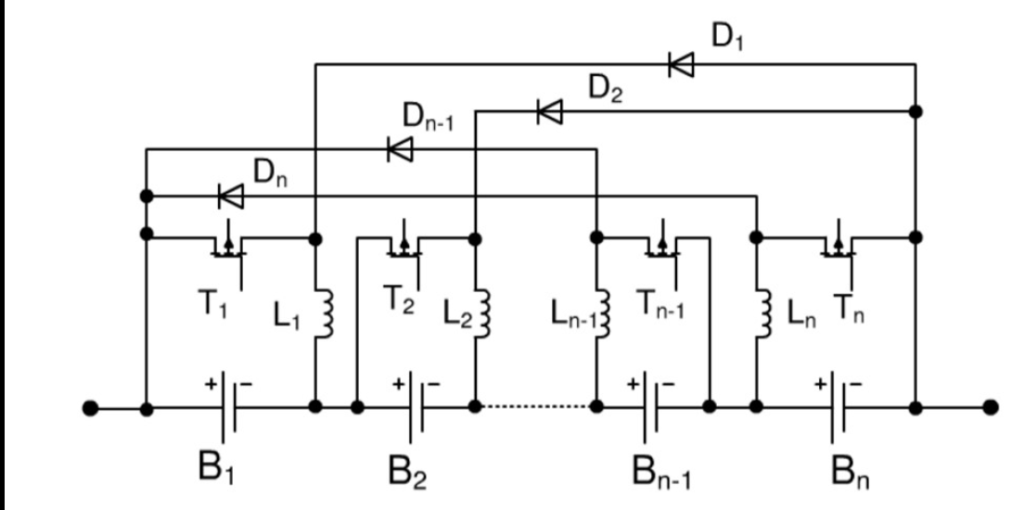
Switched inuctor equalization method
10 BMS Estimation function SOX
(1)SOC (State Of Charge), a core control algorithm of BMS, represents the current state of remaining capacity, i.e. the proportion of available battery power to the maximum available capacity of the battery. It is usually expressed as a percentage, with 100% indicating fully charged and 0% indicating fully discharged. SOC is the most important parameter in BMS because everything else is based on SOC, so its accuracy and robustness (also known as error correction) are extremely important.
(2)SOP(State Of Power, Battery Power Status) mainly obtains the available charging and discharging power of the current battery by looking up the temperature and SOC table. VCU determines how to use the current vehicle according to the sent power value. It is necessary to consider both the release of battery capacity and the protection of battery performance, such as partial power restriction before reaching the cut-off voltage. Of course, this will have a certain impact on the driving experience of the vehicle.
- SOH(State Of Health) mainly represents the current health state (battery life) of the battery, which ranges from 0 to 100%. It is generally believed that the battery will no longer be used after it falls below 80%. At present, most use capacity attenuation and DC internal resistance change to determine, generally, energy battery performance attenuation is characterized by capacity attenuation, power battery performance attenuation is characterized by DC internal resistance change.
Capacity less than 80% of the rated capacity – Online Capacity estimation: Least square method
DC internal resistance greater than 120% Nominal internal resistance – Online DCR estimation: Least square method or Extended Kalman Filter (EKF)
The actual capacity of the current battery is estimated based on the running data of the battery. The ratio between the actual capacity and the rated capacity is SOH.
Accurate SOH will improve the accuracy of other modules in estimating battery attenuation.
11 SOC Estimate technology
Current industry general algorithm:
- OCV(Open circuit Voltage)
- AH(AH balance)
- Kalman KF or EKF(Extended Kalman Filter)
- ANN(Artificial Neural Network)
1 SOC Estimate technology – OCV(Open circuit Voltage)
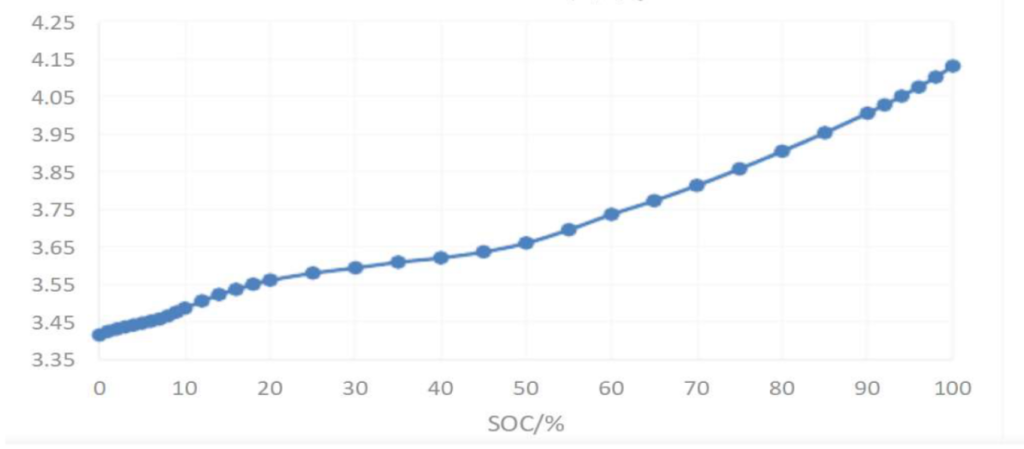
SOC-OCV curve
OCV(Open circuit Voltage):
LiFePO4 battery, charging OCV and discharge OCV have hysteresis phenomenon (similar to Ni-MH battery), and the voltage curve is flat, with a long plateau period and a small slope, and the battery voltage plateau is almost unchanged for about 70% of the time, and is affected by discharge rate and temperature are more influenced. Therefore, OCV open circuit voltage method is not suitable for LiFePO4 (lithium iron phosphate) batteries.
Although the open-circuit voltage is the same when the battery is at different temperatures or different life periods, the actual SOC may vary greatly, and the estimation results of this method cannot be guaranteed to be completely accurate for a long time.
Therefore, the OCV curve is mainly used for correction, calibration, and the error will be large if only used this method to calculate SOC.
2 SOC Estimate technology – AH(AH balance)
The calculation of the AH(AH balance):

In the formula, SOC is the state of charge; SOC0 is the state of charge at the beginning time (t0); CN is the rated capacity (the capacity of the battery under the standard state at that time, which changes with the life); η is the coulomb efficiency of charge and discharge(charge and discharge efficiency), discharge is 1 and charge is less than 1. I is the charge and discharge current, the charge is negative and the discharge is positive.
Under the condition that the initial state of charge SOC0 is relatively accurate, the AH integration method has quite a good accuracy in a period time (mainly related to the sampling accuracy and frequency of the current sensor).
However, the main disadvantages of AH integration are as follows: initial SOC0 affects SOC estimation accuracy; Coulomb efficiency η is greatly affected by the operating state of the battery (such as state of charge, temperature, current size, etc.), η needs to be obtained by conducting a large number of real measurement, the workload is large, difficult to accurately measure, will have a cumulative effect on SOC error (cumulative error); The accuracy of the current sensor, especially the deviation, will lead to cumulative effect and affect the accuracy of SOC. In the case of equilibrium, it is more difficult to measure SOC. Therefore, it is difficult to meet the accuracy requirements of SOC estimation by simply using the AH integration method.
3 SOC Estimate technology – EKF(Extended Kalman Filter)
EKF(Extended Kalman Filter):
The core idea of the extended Kalman filter method is to make the optimal estimation of the system state in the sense of least variance, i.e., to establish the state equation of the system and estimate the system state using mathematical methods such as least squares, least variance estimation, and recursive least squares estimation. The advantage of this method is that it is not sensitive to the initial SOC error. The disadvantage is that it requires high precision of battery performance model and computational capability of the battery management system.
4 SOC Estimate technology – ANN(Artificial Neural Network)
This method refers to the artificial intelligence system that simulates the biological process of the human brain. It avoids the internal complexity of the battery, uses a fuzzy neural network to model the battery, and uses the battery’s external characteristics such as the battery, voltage and temperature as input to conduct sample training. The disadvantage is that the calculation is large and the hardware requirements are high.
5 SOC Estimate technology
It is difficult for a single SOC algorithm to meet the accuracy requirements of SOC estimation, and the mainstream practice a fusion algorithm of multiple single SOC algorithms.
Mainly through the ampere-hour (AH) integral method and extended Kalman filter (EKF) algorithm, and combined with the correction strategy (such as open circuit voltage correction, full correction, charging end correction, capacity correction at different temperatures and SOH, etc.). The AH integral method is more reliable under the condition of guaranteed current acquisition accuracy, but its robustness is not strong. Due to the accumulation of errors, correction strategies must be combined, while EKF has strong robustness, but the algorithm is complex and difficult to implement.
The fusion algorithm of simple correction mainly includes open circuit voltage correction and ampere-hour integration of full current correction, etc.
Domestic mainstream manufacturers generally can achieve accuracy within 5% at room temperature, but the estimation in high and low temperatures and battery attenuation is a difficult point (inaccurate estimation can easily cause the predicted mileage is not consistent with the actual available mileage, which is very dangerous in high-speed driving).
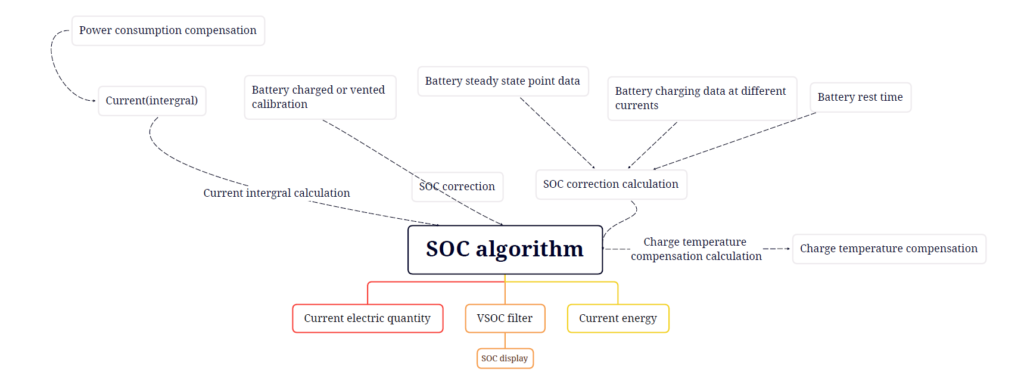
SOC estimation diagram
6 SOP Estimate technology
In recent years, the control quantity of SOP by various research institutions and various new energy vehicle factories is mostly divided into the following: discharge power within 10 seconds, discharge power within 30 seconds, charging power within 10 seconds, and charging power within 30 seconds. The power limit of discharge is well understood, while the power limit of charge is mainly a constraint on charging at high and low temperatures, and the energy feedback system. Control methods include the table look-up table method, as well as the table look-up table method combined with the equivalent circuit model prediction method. At present, most manufacturers use two-dimensional look-up table of power MAP determined by temperature-SOC, and add SOH parameter correction later.
Test method: Charge at 0.33C to 4.20V at 25°C, charge at constant voltage to the cut-off current of 0.05C, discharge at 0.33C to 2.5V at the corresponding temperature, and calibrate the capacity. Charge at 0.33C to 4.20V at 25°C, charge at constant voltage to the cut-off current of 0.05C, and leave at the temperature to be tested for 3 hours. After the corresponding peak power test, discharge 10%SOC at 0.33C, and continue testing until 0%SOC.
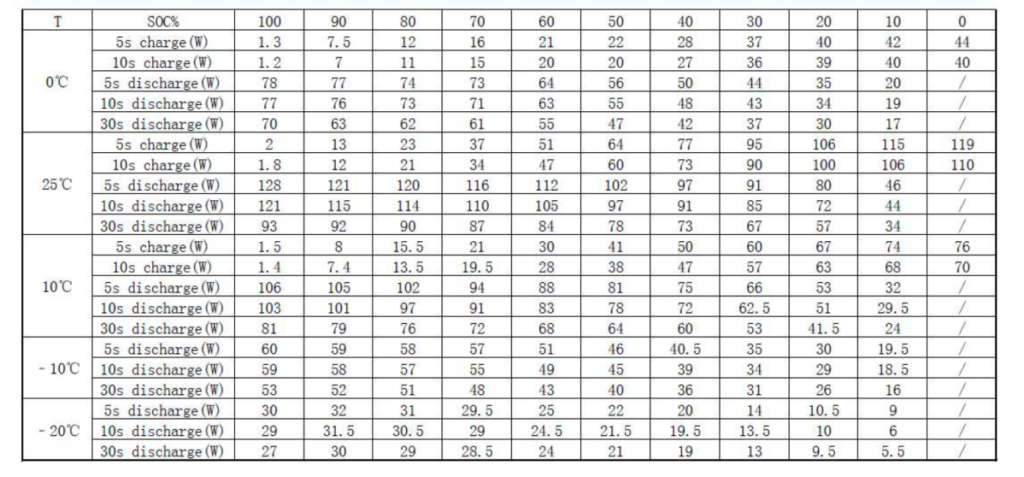
LISHEN NCM LR2170SD-3.6V5.0Ah
The following is a 3D diagram of power limits for a battery system:
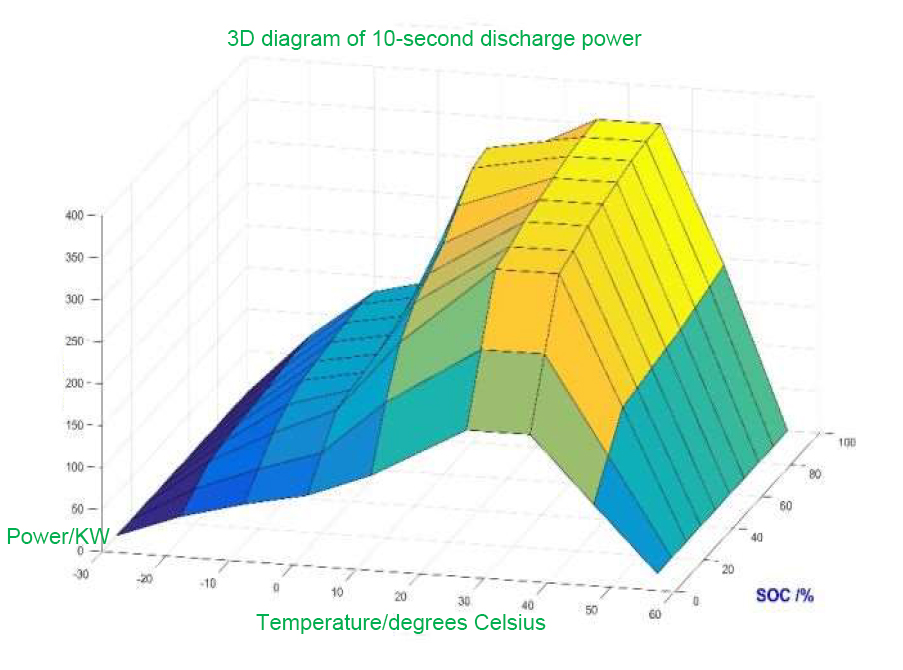
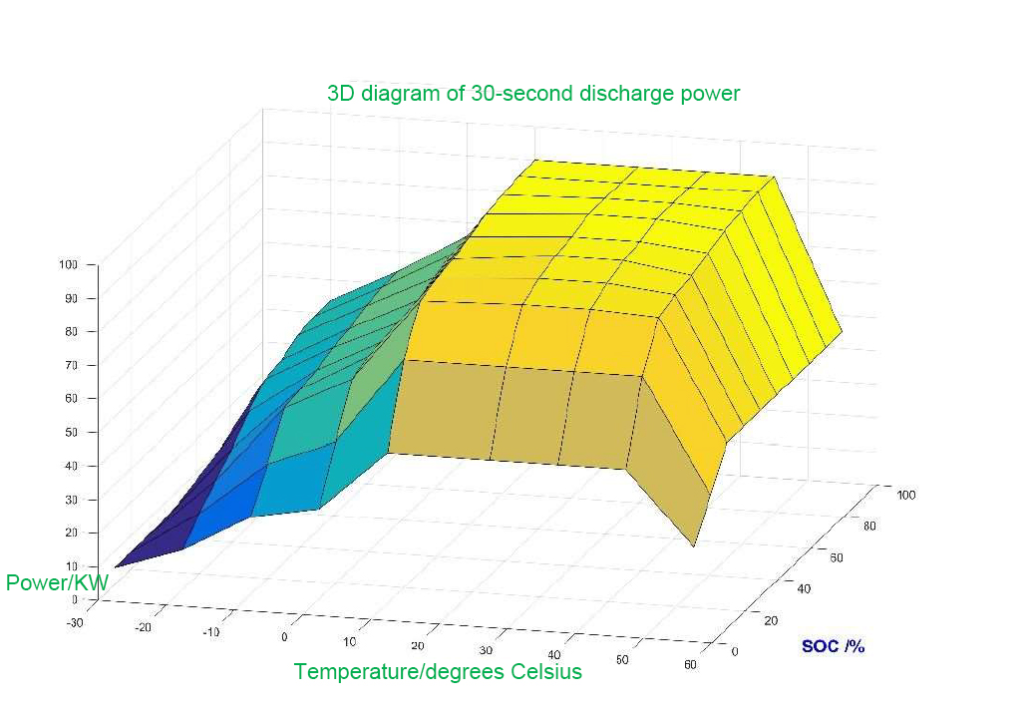
Tritek is a professional lithium battery power solution company founded in Shenzhen. Tritek offers a wide range of power solutions for LEV lithium-ion batteries for both commercial and domestic usage.
The experts at Tritek have 12 years og experience in the design, R&D, and sales of LEV lithium-ion batteries. The lithium-ion batteries produced at Tritek are compliance with global certification standards for LEV batteries, such as EN15194:2017, UN38.3, CE, FCC, CB, UL, etc. Tritek had already set up a customer service center in Spain in 2022, and Tritek Europe GmbH in Germany in 2023, also planning to set up in the United States to enhance the consumer experience.
You can customize the protection requirements of various additional functions for your lithium battery, such as communication function, SOC calculation, SOH estimation, warning function, recording function, display function, etc. Tritek can provide your battery with a professional protection board and BMS. Please CONTACT US if you are interested.
More articles on BMS:


